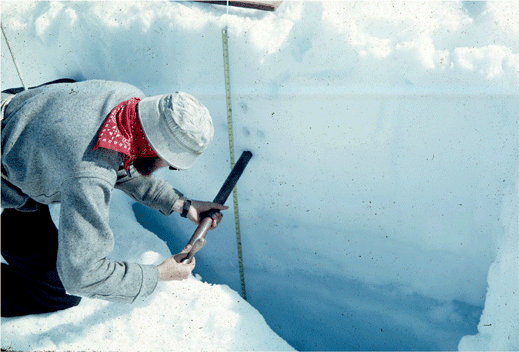Firn on:
[Wikipedia]
[Google]
[Amazon]
__NOTOC__
 Firn (; from
Firn (; from
 Firn (; from
Firn (; from Swiss German
Swiss German (Standard German: , ,Because of the many different dialects, and because there is no #Conventions, defined orthography for any of them, many different spellings can be found. and others; ) is any of the Alemannic German, Alemannic ...
"last year's", cognate with ''before'') is partially compacted névé
Névé is a young, granular type of snow which has been partially melted, refrozen and compacted, yet precedes the form of ice. This type of snow can contribute to glacier formation through the process of ''nivation''. Névé that survives a ...
, a type of snow
Snow consists of individual ice crystals that grow while suspended in the atmosphere—usually within clouds—and then fall, accumulating on the ground where they undergo further changes.
It consists of frozen crystalline water througho ...
that has been left over from past seasons and has been recrystallized into a substance denser than névé. It is ice
Ice is water that is frozen into a solid state, typically forming at or below temperatures of 0 ° C, 32 ° F, or 273.15 K. It occurs naturally on Earth, on other planets, in Oort cloud objects, and as interstellar ice. As a naturally oc ...
that is at an intermediate stage between snow and glacial ice. Firn has the appearance of wet sugar, but has a hardness that makes it extremely resistant to shovelling. Its density generally ranges from 0.35 g/cm3 to 0.9 g/cm3, and it can often be found underneath the snow that accumulates at the head of a glacier
A glacier (; or ) is a persistent body of dense ice, a form of rock, that is constantly moving downhill under its own weight. A glacier forms where the accumulation of snow exceeds its ablation over many years, often centuries. It acquires ...
.
Snowflake
A snowflake is a single ice crystal that is large enough to fall through the Earth's atmosphere as snow.Knight, C.; Knight, N. (1973). Snow crystals. Scientific American, vol. 228, no. 1, pp. 100–107.Hobbs, P.V. 1974. Ice Physics. Oxford: C ...
s are compressed under the weight of the overlying snowpack
Snowpack is an accumulation of snow that compresses with time and melts seasonally, often at high elevation or high latitude. Snowpacks are an important water resource that feed streams and rivers as they melt, sometimes leading to flooding. Snow ...
. Individual crystal
A crystal or crystalline solid is a solid material whose constituents (such as atoms, molecules, or ions) are arranged in a highly ordered microscopic structure, forming a crystal lattice that extends in all directions. In addition, macros ...
s near the melting point are semiliquid and slick, allowing them to glide along other crystal planes and to fill in the spaces between them, increasing the ice's density. Where the crystals touch, they bond together, squeezing the air between them to the surface or into bubbles.
In the summer months, the crystal metamorphosis can occur more rapidly because of water percolation between the crystals. By summer's end, the result is firn.
The minimum altitude that firn accumulates on a glacier is called the ''firn limit'', ''firn line'' or ''snowline''.
List of firns
* Antarctic Firn * Daniel Bruun Firn * Dreyer Firn * East Northwall Firn * Rink Firn * Sven Hedin Firn''Sven Hedin Firn'', Army Map Service,United States Army Corps of Engineers
The United States Army Corps of Engineers (USACE) is the military engineering branch of the United States Army. A direct reporting unit (DRU), it has three primary mission areas: Engineer Regiment, military construction, and civil wo ...
, Greenland 1:250,000
* West Northwall Firn
Other uses
In colloquial and technical language, "firn" is used to describe certain forms of old snow, including: * old snowfields, known as ''Firnfelder'' (), even if the snow is not yet one year old * the more recent snow layers of a temperate, or "firned",glacier
A glacier (; or ) is a persistent body of dense ice, a form of rock, that is constantly moving downhill under its own weight. A glacier forms where the accumulation of snow exceeds its ablation over many years, often centuries. It acquires ...
* used in skiing, the uppermost, soft layer of snow that is frozen overnight and, as a result of spring sunshine and high air temperatures, melts and reforms on an area of old snow or '' harsch'' (, referring to the snow's rough texture)
As in the last context, a ski slope that experiences melting and refreezing into ''harsch'' is said to "firn up". In Switzerland, these slopes are called ''Sulz'', but in Germany, ''Sulz'' more often refers to a depth at which skiing downhill is no longer enjoyable.
References
Sources
* * * * {{Authority control Glaciology Water ice Montane ecology Snow